

 Second coming of the movie behemoth
Second coming of the movie behemoth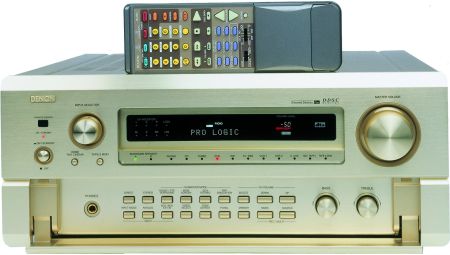
One important difference between hi-fi and home cinema amplifiers is the rapid rate of change that AV amps undergo. A stereo model of yesteryear can be a stereo model of today. Yet with surround, it's a digitally different ball game. Last year's decoding is almost passé today. Movie technology - both visually and sonically - is advancing in such leaps and bounds that amplifier manufacturers have difficulty keeping up. No sooner were we applauding Dolby Digital than DTS came along. Now there's talk that future home theatre systems will demand 7.1 channels - using additional speakers at centre rear or at the sides to add further realism to the experience.
Then there's the issue of video. Early Pro-Logic amps had just a few composite connections. Then along came S-video. Now, in the DVD age, there's baseband component video - an important feature for those with high-res video projectors.
Clearly, what we can look forward to getting from an integrated home cinema amplifier is something of a moveable feast - especially when flagship models are expected to pack everything on board. Each year we see upgrades that enhance flexibility and performance. Just 18 months ago, HCC applauded Denon's AVC-A1 as being the best integrated amplifier at any price. The only competition since has come from Yamaha's DSP-A1 and A2 models. Although not THX-certified, these amps offer a yummy specification, packing DTS decoding alongside six-channel inputs, plus oodles of DSP and hefty power output.
Now it's Denon's turn to fight back. In the spotlight is the AVC-A1D, a THX powerhouse that boasts some unique home cinema facilities. Basics include 5 x 140W output, 11 analogue and nine digital inputs (including AC-3 RF for LD players). You get DTS, Dolby Digital and Pro-Logic decoding with THX 5.1 Ultra processing (the new Lucasfilm designation). There's also component video switching, plus a rather unusual implementation of the surround outputs. All for £2,000 - some £500 less than when the original AVC-A1 first appeared on the market.
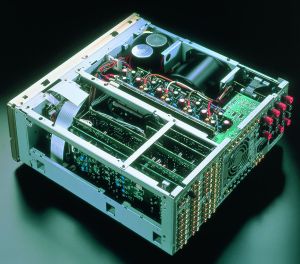 SAME BODY, DIFFERENT GUTS
SAME BODY, DIFFERENT GUTSWindow shoppers will suffer déja vu when they see the AVC-A1D - it looks just like the AVC-A1, a solid construction with champagne livery and a drop-door that hides lesser controls. Up front are two knobs: a rotary input selector and the motorised volume control. Actually, this volume knob is special. Denon's boffins have engineered variable ballistics. A 'smart' control algorithm detects whether it's turned gently or rapidly and reacts accordingly. Twiddle it slowly for 1dB steps or blow your speakers away with a rapid advance.
Sure it's a gimmick, but what the hell? For a cool two grand you expect some absurd bells a whistles.
Incidentally, don't worry about the handset doing sonic damage. This tracks at the leisurely rate of 1dB per step regardless of finger-pressure.
As home cinema amplifiers go, this box is complex. Yet the panel display is invaluable - at a glance you know what's going on. The fluorescent section shows inputs and decoding modes, with a mini digital read-out indicating the volume.
Nearby a cluster of red LEDs gives an instant sign of how many channels are being decoded, while LEDs below the main window display which source is selected. Other indicators show digital lock and the presence of DTS.
With the drawbridge raised, the only controls on show are THX and tape monitor buttons. With it lowered, you have virtually all the functions of the handset. Direct and Tone Defeat keys give highest fi by defeating DSP and tone controls. An input selector
chooses digital, analogue or RF AC-3 sources. You also have buttons for recording one source while listening or viewing another.
I'd advise you not to look at the rear panel until you have two things to hand: the instruction book and a magnifying glass; the former to follow the myriad socketry and the latter to follow the Lilliputian print.
The socketry is a minefield - but fortunately Denon has crammed it into understandable ghettoes that can be summarised as follows:
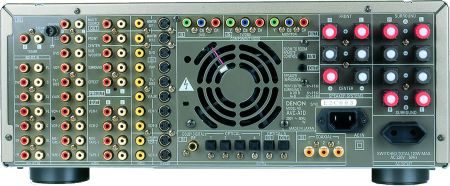
Actually, 'feature overflow' is a better description. You name it, this amplifier sports it. The basics include Dolby Digital, Pro-Logic and DTS decoding with THX 5.1 processing - all at the press of a button (or three).
So what's the difference between the 'old' THX and the 'new' THX 5.1? It's Lucasfilm's modification that integrates the basic principles of Home THX with digital soundtracks that carry stereo surrounds. On a THX amplifier there are three methods by which the audio signal is changed to help overcome the acoustic difference between a large auditorium and home cinema.
Re-equalisation gives a smoother response to the front channels. Decorrelation adds a 'difference' to rear left and right to help diffuse surround effects. Timbre-matching ensures an accurate tonal transition as action moves from front to back. You also get a fixed low-pass filter to route all LF below 80Hz to the subwoofer outputs.
The 5.1 extension is used for Dolby Digital and DTS software. It varies the decorrelation to suit the soundtrack. On movies with plenty of rear separation, no decorrelation is used - the two channels are 'different' enough to satisfy Lucasfilm requirements. But on movies where the rear channels have little or no stereo separation, full decorrelation is applied.
In practice all this is transparent.
As far as the user is concerned, THX 5.1 has become just another DSP option. I know aficionados of THX will disagree with this over-simplification, but in the retail environment that's how it's now regarded.
Alternatively, there are seven additional surround modes that can be applied to movies and music sources according to your sonic taste. They include widescreen, five-channel stereo, classic concert, rock arena, jazz club, super stadium, matrix and mono movie.
If you find the reverberation and DSP delay of these settings overpowering, there's a manual trim for varying the effect, room size and delay time. You can also vary the tone control (bass and treble) settings in 2dB steps over a +/-12dB range. And if you get spaced-out by all this echo, the Direct button returns you to the default - how the music/movie was intended to be heard.
One feature that's useful is the cinema filter. This attenuates high frequencies on the front channels and helps improve upon vintage movie soundtracks or those with strident treble. For more details on how sharply it operates, see our Under The Bonnet article overleaf.
Of all the functions offered, one is underplayed. You can connect two pairs of surround speakers and select which will be activated by a given surround mode. For example, the THX mode might trigger a pair of diffuse dipoles, but for music, a pair of point-source speakers can be selected. Even better, both pairs can be twinned to give an exaggerated spacious effect. The only downside to all this is the need to further clutter your room with extra rear speakers.
As for gimmicks, there are virtually none, other than the handset's features. It comes pre-programmed with the control codes of many popular peripherals but also has a 'system call' to execute up to 10 commands sequentially. For example you can tell it to switch on the amp, select the DVD input with DTS decoding, then switch on the TV and finally trigger the television's AV input. All very clever.
The AVC-A1D is not unique in terms of decoding and DSP. Other high-end amplifiers and pre-power combos (such as the Sony TAE-9000/TAN-9000) deliver broadly similar functions - albeit without THX. But where this Denon is different is in its simplicity of setup. Unlike the Sony combo (look out for full review in the future - when we find one that doesn't explode!), the settings are intuitive. You almost don't need to read the instructions to calibrate and level-match it for your room.
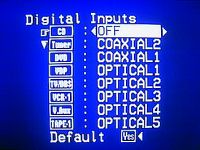
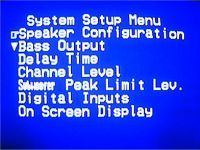
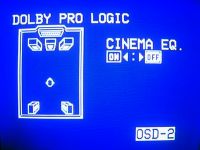
There's an onscreen menu with eight settings - speaker configuration, bass output, delay time, channel level, subwoofer peak limit, digital inputs, tone control and onscreen display.
The speaker settings offer small/large settings for the front boxes and small/large/none for surround. Additionally you must set whether there are rears on the 'A' or 'B' terminals and which surround mode uses which surround pair.
Top marks to Denon for explaining in its manual exactly what is meant by 'large' or 'small' speakers. It's not necessarily the physical size, but the ability to reproduce signals below 80Hz. Hence THX models - such as the splendid KEF Reference series I use - are big boxes designed to cut off at 80Hz, and therefore regarded as being 'small' in Denon parlance.
All this is important when it comes to bass output and THX operation. When you set 'large', the full bandwidth is output, but 'small' routes bass via the subwoofer. You can select whether this happens only with THX processing or throughout all surround modes.
The delay settings are standard for digital surround amplifiers. For newcomers, let me explain what happens: When you're sitting in a multi-speaker environment, it's likely that the sound from one or more speakers will arrive at different times because of variations in distance. On Dolby Digital and DTS material this can lead to some strange effects - for example, off-screen sounds might be out of sync with onscreen action. By time-aligning the signals (ie introducing a few milliseconds' delay) you bring the soundstage back into focus. Denon displays the delay as distance in feet (or metres) rather than milliseconds, which need to be calculated on a chart.
Another useful offering is the subwoofer peak limit. In this mode a special LF test tone is output via the subwoofer. Increasing the level will make the cutlery rattle in your sideboard. You advance the vibrating tone until you reach the peak of your sanity. Once set, the subwoofer signals will not exceed this 'oomph' level.
Finally, there are the digital inputs - many more than found on the original AVC-A1. You are offered a list of the physical terminals and optical/coaxial options. So for example, the DVD feed can be Optical-1, the LD DTS feed might be Optical-2 and a CD player could be Coaxial-1. But watch out. It's not totally intuitive; for Dolby Digital LDs you must additionally hook up the AC-3 RF feed and select this manually with the Input Mode selector on the handset.
So how does this big box sound? In a word, 'stunning' - but not in the way that you might think. Although you'll surely be awed by its powerful delivery, the reason this amp is so remarkable is that it handles both music and movies with equal aplomb. First into my Sony DVP-M35 DVD player was Mars Attacks!. Why? Because Chapter 13, From Dove To Devastation, is a microcosm of movie sound. It has firm dialogue at centre, symphonic music and action at front and on surrounds, plus a fair wallop of LFE on the subwoofer channel.
All this, the Denon took in its stride with astonishing control. You notice the effortless handling as the music reaches a crescendo and the helicopters accompany the humming 'hubcap' to the desert floor. The chopper's whine can be tamed by using THX. It sure sounds smoother and (if we believe Lucasfilm) it's more accurate. But does it also remove some of the treble attack that would otherwise impress? Maybe so - but it depends on the movie. Although I preferred the 'Ack Ack' alien-speak in unfettered Dolby Digital, The Fifth Element was a different story. On Chapter 43 of the LD (the diva concert sequence) THX processing was favoured for its smoother handling of the singing, alternated with shoot-'em-up-action effects.
And DTS? To the Jurassic Park LD and those foreboding footsteps as T-Rex wobbles puddles and everything else in its path. BAMM! BAMM! - believe me, it's brilliant. DTS really does add a tremendous extra depth which must be heard to be appreciated.
As for surround separation - it's total. We're talking zero front-to-surround bleed.
My final subjective test was the clincher. Sony has just launched four 'Legacy' series Herbert Von Karajan concerts on DVD, remixed for 5.1 surround. I chose Beethoven's 9th Choral Symphony. Wow! It's sheer musicality. Coupled with the ultra-sharp pictures, this is the nearest thing to a front row seat in the Berlin hall where this concert was recorded in the 1980s. From bassoon to double bass, violin, flute and percussion, the sonics have a perspective that's both powerful and subtle. Shut your eyes (or turn off the TV) and the sonic picture remains - every instrument is placed perfectly.
Somehow, the Dolby Digital 5.1 captures the ambience in a way not fully realised in the PCM stereo track. Yes, PCM should sound better (it has no data compression), but I challenge you to listen and tell me that Dolby Digital decoded via this Denon is not of the highest fi. A measure of its effect upon me was that I listened to the whole disc and totally forgot about 'reviewing'.
|
FOCUS | |
| Sound | |
| Looks | |
| Features | |
| Overall | |
|
Model : Denon
AVC-A1D | |
This is an awesome amplifier that combines everything that's good about home cinema - powerful transient handling, brilliant surround decoding, THX processing for movies and musicality for CDs. Whatever your source signal, this box can handle it with precision and passion.
So, is it better than the Yamaha DSP-A1? As a Yamaha user and admirer, I have to somewhat sniffily admit it probably is. It's warmer and more adroit at handling music. But only by a whisker.
For purchasers considering their first 'serious' (read 'expensive') home cinema amplifier, the Denon AVC-A1D should be top of the auditioning list - placed alongside the £1,600 Yamaha DSP-A1. Consider the sonics and facilities. When it comes to the crunch, it's up to you to decide how much extra cash the musicality and THX processing is worth to you.
Although the Denon AVC-A1D may look identical to its AVC-A1 predecessor, the similarity is only skin-deep. Under the bonnet we find a powerhouse that's both technically and physically improved, and very different from contemporary Dolby Digital/DTS competitors. The construction is unusual; instead of the power output devices being laid in a horizontal plane and coupled to pre-drivers and motherboard (a design employed by many brands including Sony and Yamaha), the output stages are constructed within a block assembly that runs from front to back, straddling the power supply and DSP electronics on either side. It's an unusual way of saving space, yet ensures the output transistors are afforded equal treatment - giving linear channel balance and thermal quiescent current stability.
The amplifier block features independent fans at input and output - one is mounted on the rear panel, the other just behind the front panel with exhaust slots that vent into the base. An advanced temperature sensor circuit provides a four-stage cooling action: 1. No fans - passive cooling only. 2. Front fan on low speed. 3. Rear fan off, front fan on low speed. 4. Rear and front fan on high speed.
One might expect this air-blowing protection to cause undue noise. However, on test in the lab, where the output stages are run at maximum for some time, the fans were almost silent. In fact, the cooling system is far quieter than that employed on HCC's state-of-the-art laboratory equipment.
It's not just the output stages that are sophisticated. The digital processing (mounted to the right of the output block) is bang up to date too. The Dolby Digital and DTS decoding is provided by two Analogue Devices 32-bit floating-point processor chips (type ADSP-21061L) using SHARC (Super Harvard Architecture Computer) technology. One chip handles the decoding functions while the other provides THX 5.1 post-processing.
The chips are loaded with the appropriate algorithm for AC-3/DTS/DSP as the decoding function is selected, and were developed by Analogue Devices in consultation with Nippon Columbia (Denon) engineers to deliver a 50-MIPS (millions of instructions per second) operating speed.
Denon has also made great efforts with low-distortion D/A conversion. This amplifier uses the same 96kHz 24-bit D/A converters as Denon's audiophile DVD-5000 DVD player. A dedicated converter is used on each of the five main channels, plus one on the '.1' subwoofer channel ahead of the pre-amplifier output stages
In the lab I measured not only the audio parameters of the Denon AVC-A1D, but its video signal path too, setting the same stringent limits as the latest high-end DVD players. After all, what point an AV amplifier if its video circuits interfere with the resolution or colour fidelity of the signal? The following shows the lab measurements, followed by a discussion of how this compares with a 'direct' video signal.
Inherent s/n ratio: -73.40dB Frequency response @ 4.8MHz: -3.13dB
Frequency response @ 5.8MHz: -3.07dB Chroma AM: -74.2dB
Chroma PM: -71.1dB
Video jitter: 3ns peak to peak
So what do these signals mean? To understand them we need to compare them with a direct signal. By 'direct' I mean a video signal fed directly from a signal generator to a spectrum analyser using the same (relatively lossy) domestic video cables as for the signals fed to the AVC-A1D under test.
In terms of video s/n there's a 1dB increase in noise, the direct path measuring a slightly better -74.4dB. However, such a minute increase in 'fizz' is unlikely to be perceived by the naked eye.
In terms of frequency response, this Denon actually improves upon the losses occurring within the video cables. A direct link measured -4.38dB from reference at 4.8MHz and -4.43dB at 5.8MHz. Via the amplifier they measured around 1.2dB better.
With Chroma AM/PM (a measurement of amplitude and phase noise present in the colour signal) the direct and amplifier paths are identical at -74.2/-71.1dB respectively.
Video jitter is also the same via both paths. I measured just 3ns of horizontal sync instability, which is very low indeed.
In summary, this amplifier is almost transparent to video signals. Sensitive lab gear detected a worsening in video noise and a slight increase in video gain, but both are so low as to be negligible in terms of domestic video throughput.
Manufacturer's rated output: 140W per channel
Max output at onset of clipping: 175.6W RMS @ 2.9 per cent THD
HCC Fidelity Firewall output: 146.7W RMS @ 0.109 per cent THD
Frequency response: 20Hz-20kHz +/-0.5dB
As usual, I tested the power output at maximum (just before the onset of clipping) and at a more realistic level where distortion on both channels stabilised. Denon's rating is 140W per channel. I measured 175.6W RMS at the clip point with a hefty 2.9 per cent THD. Yet the HCC Fidelity Firewall figure (allowing a meagre 0.109 per cent THD) measured at 146.7W, a tad greater than the manufacturer's ratings. This is good news. Denon is not overrating its figures. In practical terms there's no need; this is genuinely a 140W amplifier.
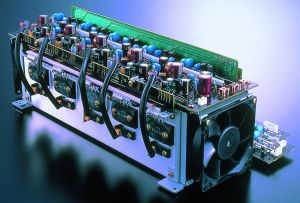 In terms of frequency response
this amp is ruler flat (see figure A), a sweep in the 'direct' mode revealing no
anomalies in the audible spectrum and virtually no imbalance between channels in
stereo mode.
In terms of frequency response
this amp is ruler flat (see figure A), a sweep in the 'direct' mode revealing no
anomalies in the audible spectrum and virtually no imbalance between channels in
stereo mode.
As with all amplifiers, I conducted a stability test with the amplifier running under open-circuit and short-circuit conditions (this is particularly important on a model claiming THX standards) and can report no adverse effects.
In the open circuit mode with 10m cable attached, no fireworks occurred. When the cables were shorted, the amplifier smartly shut down - as it should.
Given the AVC-A1D's THX Ultra rating, I've decided to include additional observations about its treatment of signals in THX and other DSP modes. Figures B to E show a graphical representation of the results.
A sweep with THX engaged showed a slight yet pronounced decrease in high frequency response around 8kHz with a -2dB drop, to 20kHz with a -7dB drop. This is the action of THX HF re-equalisation.
But lest you assume that the Pro-Logic mode's Cinema Filter is identical, think again. Figure C shows a different gradient, from 4kHz (-2dB) to 20kHz where a -10dB drop is heard. In layman's terms, the rate of attack on high-midband and high order signals is more prominent than basic THX re-eq.
And what of the frequency response when you engage various DSP modes? From a technical viewpoint it's laughable - just take a look at figures D and E for the widescreen and mono movie modes. The response resembles a dog's hind leg as it darts up and down.
Notable potholes are at 90Hz and 10kHz with peaks at 100Hz and 1kHz. All this may deliver a sonically exciting effect, yet compared with the original source signal it's all hopelessly inaccurate. If you're a purist, be aware that fidelity is the first casualty of DSP.

Figure A: Here we see a flat frequency response in stereo mode. Figure B, below, shows the curve with THX engaged and Figure C the curve with the cinema filter. Figures D and E demonstrate how the response is tailored by the widescreen and mono movie modes

Figure B: Note the THX curve droops around 8kHz - as per the Lucasfilm specification

Figure C: Denon's cinema filter curve droops at 4kHz - giving a more gentle trim of high frequencies than the THX mode

Figure D: Widescreen DSP response shows irregular peaks from 300Hz to 15kHz - not what the director intended

Figure E: Mono Movie DSP shows deep dips at 90Hz and 10kHz - like it or loathe it
Bob Tomalski, Home Cinema Choice, June 1999
Notes :
- We have listed all the reviews from the home cinema choice archive including items which are no longer current. This is because people may be purchasing equipment second-hand and are interested in reading how it performed in the Home Cinema Choice labs.
- The ratings given to equipment were in relation to the equipment (and prices) at the time of the review. It is fair to assume that if judged alongside more modern equipment, older models would not necessarily receive as high a rating.
- The price published here is the manufacturer’s suggested retail price at the time of the review. The ‘street’ price is often lower. And remember, as equipment becomes older, its price usually falls.